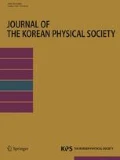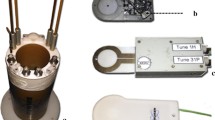Abstract
A histology coil is a U-shaped radio-frequency (RF) coil that is designed to provide a high signal-to-noise ratio (SNR) in magnetic resonance imaging (MRI) of microscopically thin samples. In this work, we demonstrate an inductively coupled histology coil that can be easily integrated with a human MRI scanner, providing a simple method to conduct novel, microscopic imaging experiments in a clinical scanner. All experiments were conducted in a 3T whole-body MRI scanner. The coil consisted of a U-shaped copper foil with tuning capacitors shunting the ends of the “U”. This design maximizes the B1-field efficiency and the homogeneity in the coil’s cavity. For inductive coupling, the histology coil was connected to an untuned single-turn pick-up loop via a coaxial cable. A standard 3T receive-only surface coil, connected to the scanner’s standard receive circuitry, was then inductively coupled to the pick-up loop. Separately, the RF pulse transmitted from the MRI body coil inductively drove the histology coil. In gel phantom imaging, we confirmed a higher (threefold) SNR for the histology coil than for the scanner’s standard surface coil, as well as high B1 homogeneity for the histology coil. Gradient echo images of a 40-µm-thick rat brain slice, at an in-plane resolution of 219 × 219 µm2, could be obtained with SNR > 10 (in the cortex) in about 2 hours. Our work demonstrates the feasibility of imaging microscopically thin tissue slices in a clinical MRI scanner using an inductively coupled histology coil. The method can be applied to multi-modality and multi-orientation imaging of ex-vivo and engineered tissue samples.
Similar content being viewed by others
References
M. D. Meadowcroft et al., Magn. Reson. Med. 57, 835 (2007).
D. M. Hoang et al., Magn. Reson. Med. 71, 1932 (2014).
H. Xu, S. F. Othman and R. L. Magin, J. Biosci. Bioeng. 106, 515 (2008).
Y. S. Zhang and J. Yao, Trends Biotechnol. 36, 403 (2018).
R. W. Bowtell et al., Philos. Trans. R. Soc. A 333, 547 (1990).
H. Weber et al., Magn. Reson. Mater. Phy. 24, 137 (2011).
O. Nykanen et al., Magn. Reson. Med. 80, 2702 (2018).
H. Wei et al., Magn. Reson. Med. 78, 1683 (2017).
C. Liu, Magn. Reson. Med. 63, 1471 (2010).
S. Wharton and R. Bowtell, Proc. Natl. Acad. Sci. U.S.A. 109, 18559 (2012).
W. Li et al., Neuroimage 59, 2088 (2012).
W. A. Edelstein et al., Magn. Reson. Med. 3, 604 (1986).
H. P. Fautz et al., 16th Annual Meeting of ISMRM (Toronto, Canada, 2008), p.1247.
J. L. Mispelter, M. Lupu and A. Briguet, NMR Probeheads for Biophysical and Biomedical Experiments: Theoretical Principles & Practical Guidelines (Imperial College Press, London, 2006), p. 596.
R. H. Hashemi, W. G. Bradley and C. J. Lisanti, MRI: The Basics (Wolters Kluwer Health, Philadelphia, 2012).
S-K. Lee et al., Magn. Reson. Med. 80, 2109 (2018).
S. S. Hidalgo-Tobon, Concepts Magn. Reson. Part A 36, 223 (2010).
Bruker Biospin 15.2 T. [cited 2019 07/09]; Available from: https://www.bruker.com/products/mr/preclinicalmri/biospec/technical-details.html.
F. G. Shellock, J. Magn. Reson. Imaging 12, 30 (2000).
S-K. Lee et al., Magn. Reson. Med. 76, 1939 (2016).
S. Richardson et al., Magn. Reson. Med. 72, 1151 (2014).
N. Hanninen et al., Sci. Rep. 7, 9606 (2017).
W. Li et al., NMR Biomed. 30, e3540 (2017).
S. H. Hwang and S. K. Lee, Investig. Magn. Reson. Imaging 22, 141 (2018).
J. H. Kim et al., PLoS One 14, e0220639 (2019).
N. A. Bock et al., Magn. Reson. Med. 54, 1311 (2005).
Acknowledgments
This work was supported by the Institute for Basic Science (IBS-R015-D1) and by the National Research Foundation of Korea (NRF) grant funded by the Korean government (MSIT) (No. 2019R1A2C1006448). The authors thank Ms. Hye-Sook Lee for help with the histology samples.
Author information
Authors and Affiliations
Corresponding author
Rights and permissions
About this article
Cite this article
Song, BP., Kim, HS., Kim, KN. et al. Inductively Coupled RF Coil for Imaging a 40 µm-Thick Histology Sample in a Clinical MRI Scanner. J. Korean Phys. Soc. 77, 87–93 (2020). https://doi.org/10.3938/jkps.77.87
Received:
Revised:
Accepted:
Published:
Issue Date:
DOI: https://doi.org/10.3938/jkps.77.87




